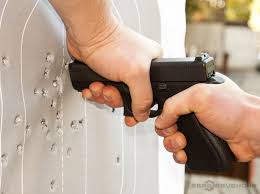One of the biggest epiphanies I had in my martial arts life was watching Gracie Jiu-jitsu in Action in 1988.
It is probably too hard to fathom what this did for me. Seeing grappling work so well against different arts was like a gut shot. It woke me up to what was possible, as well as the probability that I was had not seen the total package of fighting. What the UFC did for a lot of people in 1993, and then later in 2005 when it hit the mainstream, was what I felt in ’88.
This video is actually one of my favorite parts of the first volume. Here is the quick back story. There was a karate instructor in Rio who was looking to prove the superiority of his art and decided that challenging the Gracies was a good idea. He most likely thought that they would want so many rules and be on soft mats that he would not have to actually face them. To his shock, the Gracies agreed to all his conditions and even suggested using the location (which I will get to in a moment). There are a number of important takeaways from this short video, and they are easily understood lessons if people would look at it with a critical eye.
First of all, this video took place in the late 70’s and was made widely available on the original mass marketed video tape in 1988, and yet there are some who keep spouting ideas that this video trashes.
- Note the surface. It is the kind of hard and unyielding surface you might find on a public racquetball court. It is most certainly NOT a nice padded mat. And the ones who wanted this surface? That’s right, the grapplers. Of course, that should be impossible because all the combative experts say grapplers won’t be able to fight when they are not on mats, that somehow they will freeze when they are on a solid surface and they will be at the mercy of the non-grappler. Utter crap. It isn’t that big a deal to fight on a hard surface. No grappler wants to continually train on it, because it will eventually cause accumulated trauma and damage. But that is over YEARS of training, and has nothing to do with a single particular instance. As this video aptly demonstrates over multiple fights. Find any single moment where the BJJ practitioner is having trouble with moving on essentially concrete. You won’t find it, just as you won’t find it happening in any of the countless hundreds or even thousands of real world videos showing people using grappling to defend themselves. It is a moot point and another illustration of why those combative “experts” who have no grappling experience have no idea of what they are talking about.
- Note the absence of gloves. Bare knuckle striking, done by stand up fighters who spend all their time using bare knuckle strikes. There is no chance of hiding behind the old trope of “well, the gloves softened the blows and made the strikers less effective”. The grapplers let the strikers have yet another advantage and it made no difference.
- Note that even with the bare knuckles, the strikes had no effect. Most of the time, the karate men got off only one or at most two strikes before they were tied up and taken down. Striking is a great and useful tool, but thinking that you will be able to end a fight against an adrenalized opponent with one or two strikes generally falls in the fantasy camp.
- Note that even though most of the jiu-jitsu fighters did not have a particularly great method of closing the gap, it still worked 100% of the time. Most of them were turtle your head and dive forward type close, and it did not matter. Imagine if instead it had been a good collegiate wrestler or trained MMA fighter. How much better that close would have been. If you do not train and have practiced to deal with a true grappling close, you will fall victim to it far more often than not. You are fooling yourself if you think you can handle it otherwise.
- Note that unlike the striker that the jiu-jitsu man could strike at will once he had established positional dominance and the other man was completely at his mercy. That is a much more sure way of being effective with your strikes.
- Note in the last fight the attempt to smash the grappler backwards to the ground. Again, according to combative “experts”, this should be sufficient to stop the grappler and let the other man escape, and yet once again that kind of wisdom fails in reality. Even slammed to the hard surface by someone 40 pounds heavier on top did not shake the positional dominance of the grappler and the choke still happened right after.
As I said, I love this video for all the short and immensely powerful lessons it provides. Learn from it.

